I’ve ridden Can-Am’s new electric motorcycles – and they’re the best case so far for ditching polluting commuter bikes
Sleek, stylish, fun... and still a bit too expensive
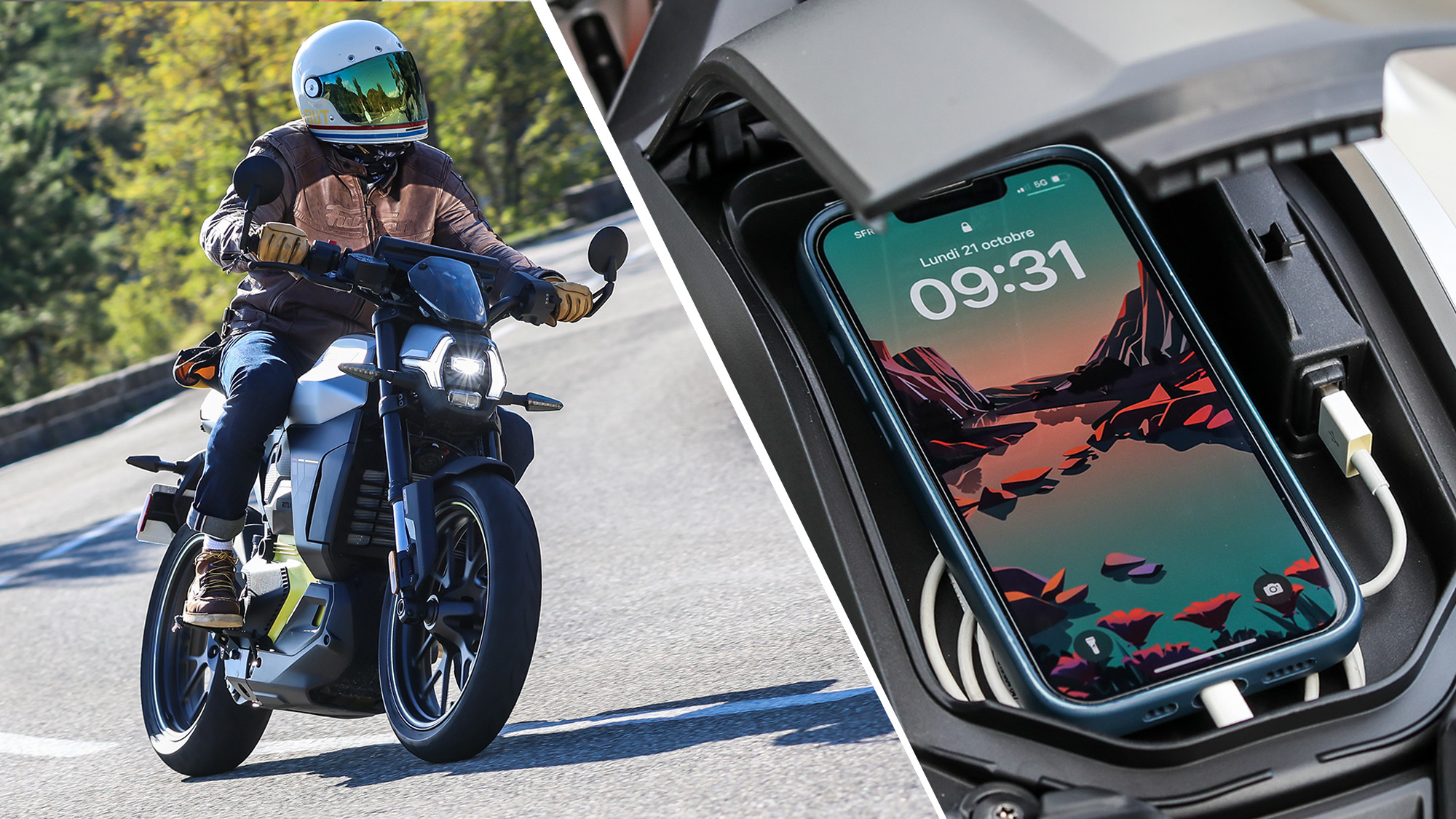
Unless you have a penchant for tearing up snowy landscapes aboard a Ski-Doo or thrashing through the woodlands in a Rotax-powered all-terrain vehicle, the BRP (Bombardier Recreational Products) badge probably isn’t going to register.
Born in Canada and formerly under the Bombardier banner, the burgeoning company raced off-road motorcycles under the Can-Am brand throughout the 1970s, took to the slopes with Ski-Doo, and then hit the water later with Sea-Doo.
After veering off into boats, forklifts and the slightly madcap three-wheel road machines (check out the Spyder and Ryker models), it is now arguably the most prevalent provider of off-road japes in the world, producing vehicles that induce massive grins on most terrain.
But it is on a mission to revive its two-wheel history with something aptly futuristic: a range of all-electric motorcycles that it says cater for both newcomers and seasoned riders.

Currently consisting of the agile, naked, city-slicking Pulse and the more robust, dual-sport Origin (the taller of the two models), the new line-up pairs battery electric vehicle innovation, such as an entirely liquid-cooled powertrain – a first in the industry – and a massive 10.25-inch, Apple CarPlay-infused infotainment system, with potent performance and an approachable riding experience to boot.
The company has big aspirations, launching in Canada, North America and much of Europe, harnessing its economies of scale and learnings from its wider off-road operations to offer an electric two-wheel solution that, while not exactly cheap, is more affordable than much of the admittedly scant competition.
Both models are on sale now, with production due to start in November and deliveries starting next year. Prices start at $13,999 / £14,899 /AU$21,000 for the Pulse and rise to $14,499 /£15,399 / AU$22,500 for the more off-road biased Origin, with no price difference between the lower-powered, more beginner-friendly 11kW model and the full-fat 35kW version. And I've taken both for a spin...
Get daily insight, inspiration and deals in your inbox
Sign up for breaking news, reviews, opinion, top tech deals, and more.
Finger on the Pulse
Despite riding both the dual-sport Origin and the more city-friendly Pulse, it’s probably best to focus on the latter, purely because this is the model that is likely to appeal to the broadest audience.
Its lower seat height, nimble handling and easy-going demeanor make it the perfect bike for busy commutes and weekend fun runs. The Origin, on the other hand, is more adept at taking to the trails, with its raised suspension, narrow seat and mud-plugging Dunlop tires reducing its comfort and handling on the road somewhat. Also, its range (or lack thereof) might limit folk actually reaching the trails before batteries require brimming.
Both bikes come with an innovative, liquid-cooled 8.9kWh battery that’s mated to either an 11kW or 35kW electric motor with up to 47hp output. The lower-powered option means it is available in Europe and other markets that allow for bikes to be ridden with more accessible licenses, such as the A1 license in the UK.
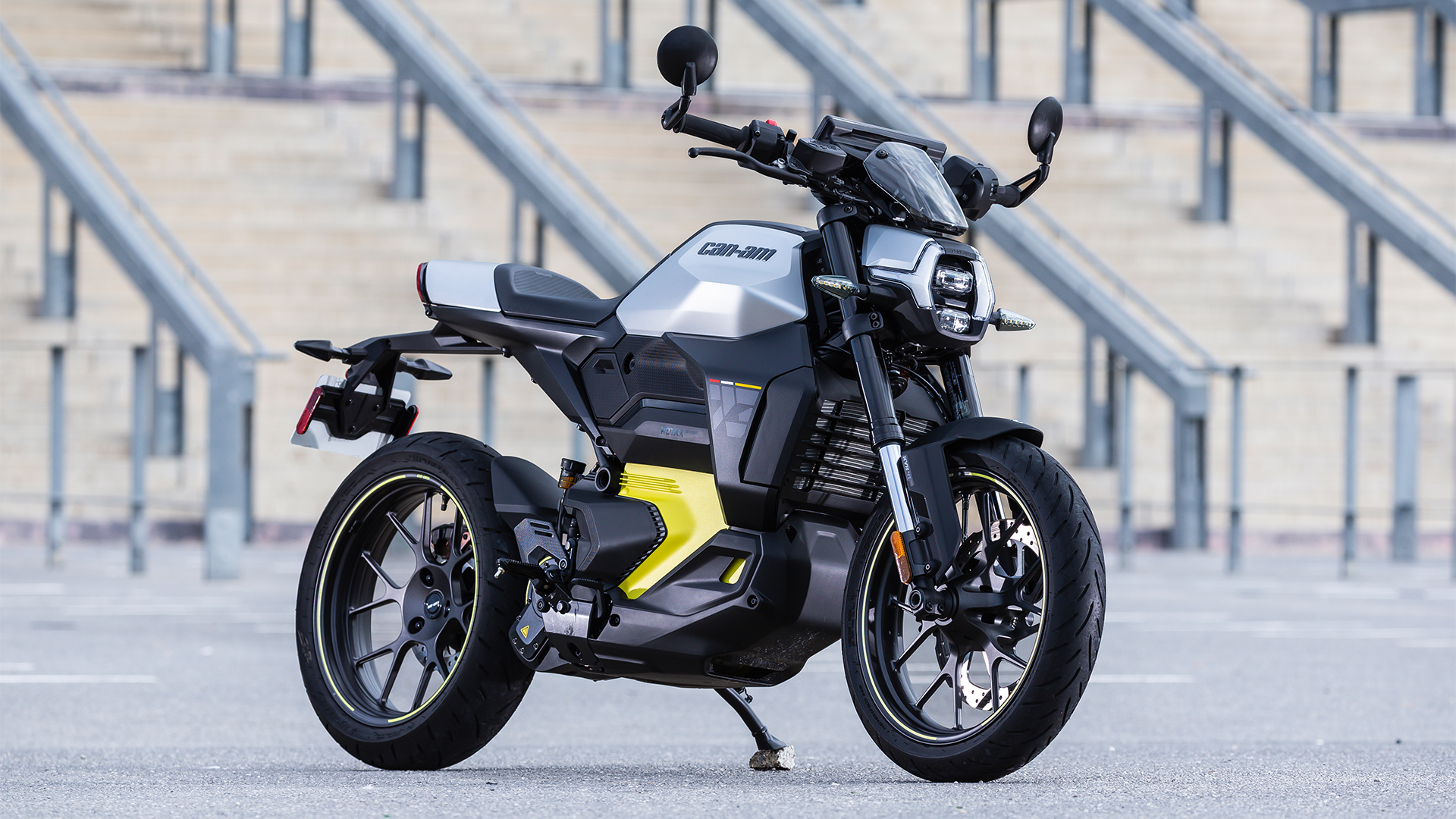
Although the 11kW bikes sound like they are under-gunned, they actually offer the same top speed, the same levels of tech and the same riding experience as the 35kW machines – making them a very enticing package for those who can’t afford, or simply don’t fancy, securing a full bike license.
Infotainment is taken care of by a whopping 10.25-inch touchscreen display, which plays nicely with the Apple CarPlay ecosystem. Can-Am says Android compatibility is coming at a later date and, seeing as the operating system can be updated via Wi-Fi, it will arrive in the form of a simple over-the-air update.
The second mechanical innovation is the covered chain case and silent chain system that forms the final drive. Where most rivals, including some combustion engine bikes, now make do with a sturdy carbon belt to drive the rear wheel, Can-Am has opted for a chain system that is found on other BRP products, such as its Ski-Doo range of hardened snowmobiles.
It is supposedly more robust, easier to maintain and helps to reduce compression on the rear suspension under hard acceleration – or anti-squat to those knowledgable biker types.
Easy to ride, easy (ish) to own
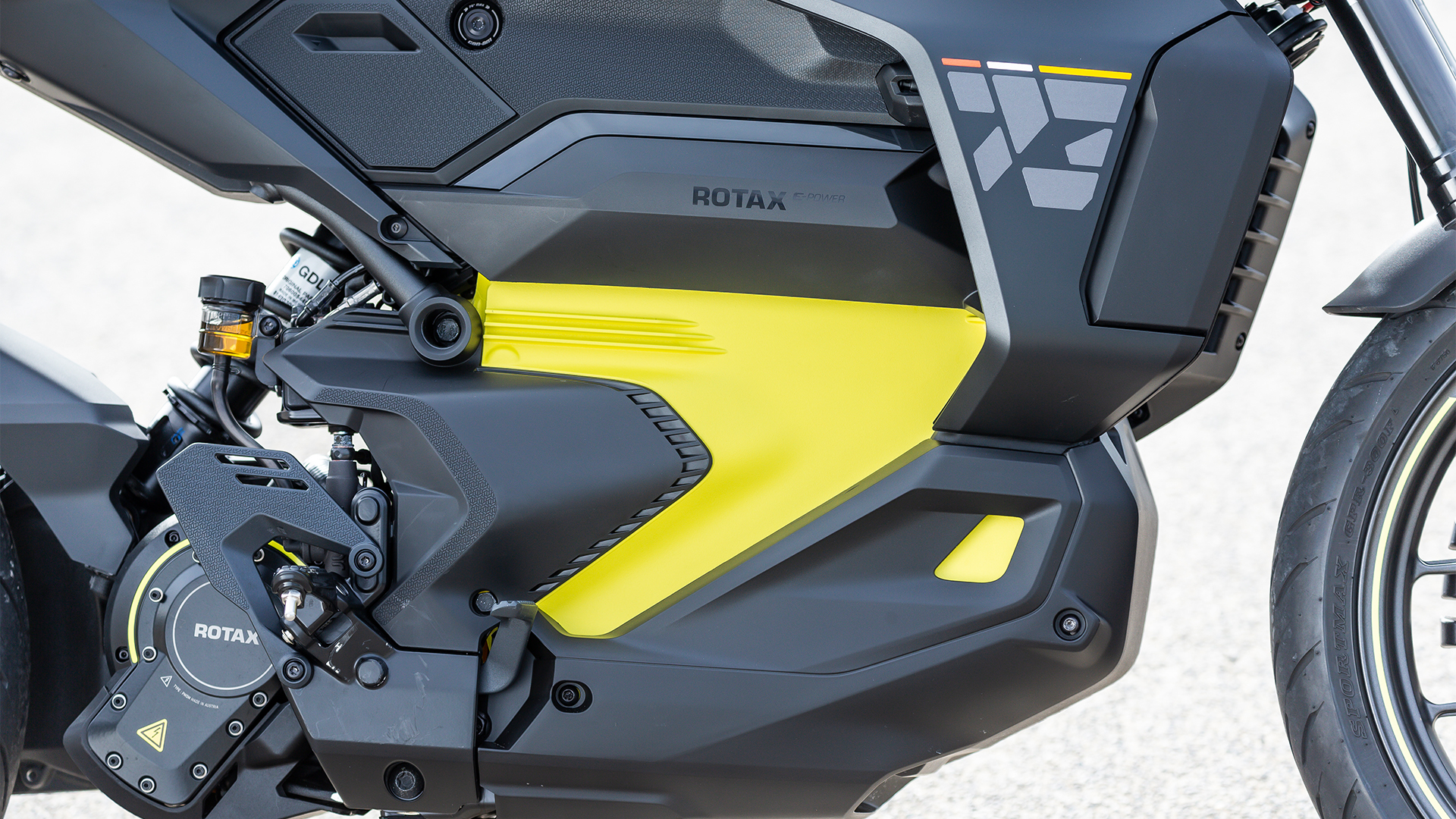
Taking inspiration from the snowy owl, Can-Am’s design team says the bikes are stealthy, futuristic but with a few nods to the company’s trail-riding past.
The Pulse looks great. It is squat, muscular and athletic, but with a seating and riding position that will suit most body shapes and sizes. What's more, Can-Am's design team has splashed the Rotax-fettled battery packs with some dashing yellow, so everyone knows this is an EV.
The tallest riders might find the Pulse a little too compact, but its proportions make it perfect for slashing through city traffic and, what’s more, Can-Am wants to appeal to more new riders and female buyers, so approachability is key.
Like most rivals in the electric two-wheeler market (there aren’t many), there’s no clutch to contend with, merely a ‘twist-and-go’ throttle and a front brake, which is mounted to the bars, and a traditional rear foot brake.
In terms of usability, it’s all very simple and laid back. Twist the key, follow the on-screen prompts for the start-up procedure and away you go… at whiplash pace if you’re not careful with the throttle. There’s even a reverse gear to make maneuvring into tight spots a breeze.
Can-Am’s innovation in the liquid-cooled powertrain goes against the general trend for air-cooling battery packs. But the company’s engineers believe relying on air alone can lead to uneven battery degradation, where some packs are inevitably not cooled as efficiently as others.
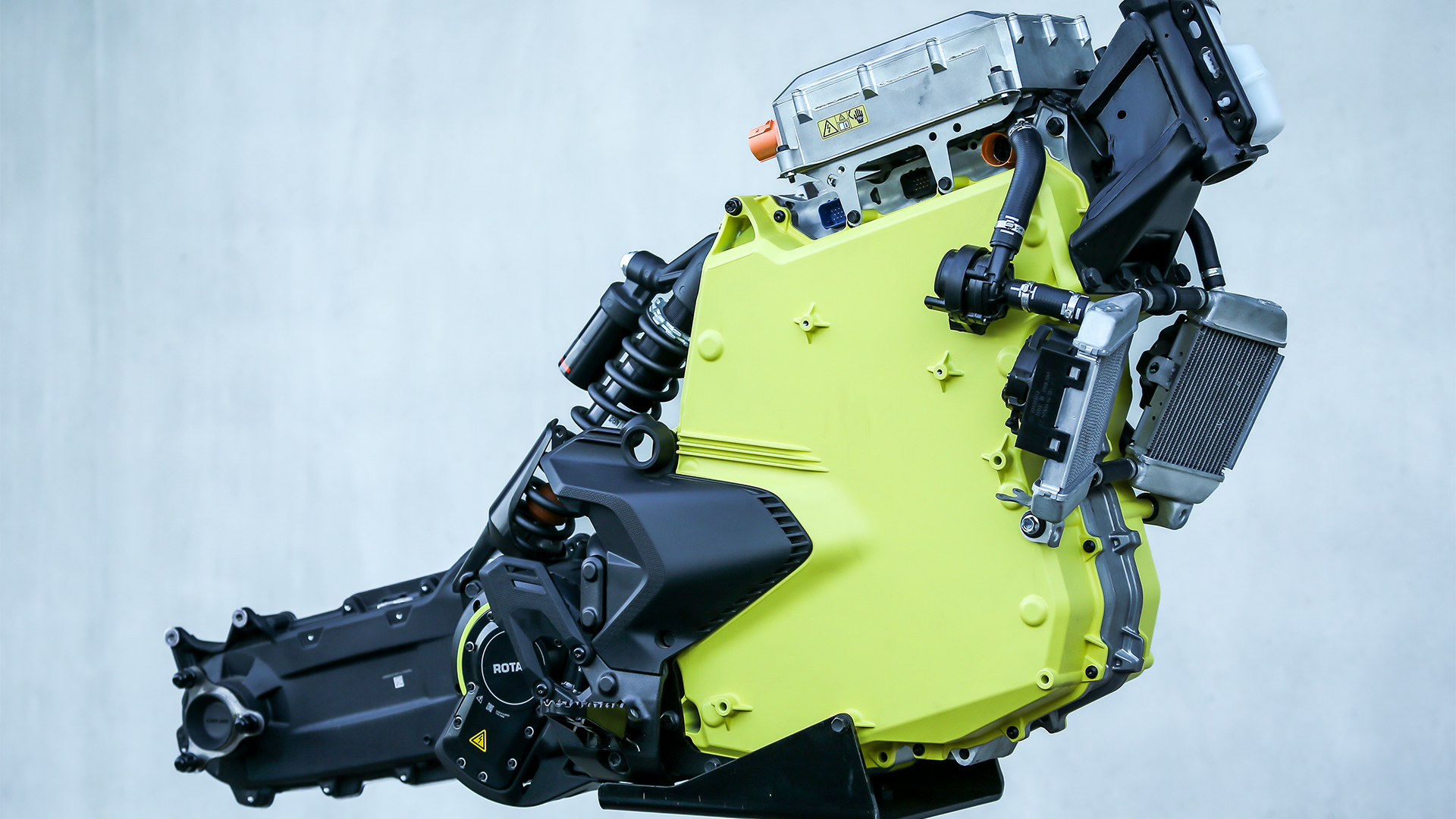
As is the way with battery chemistry, the overall pack is only as good as the most deteriorated cell, so Can-Am is keen to boost longevity by cooling its battery, charger, inverter and motor, which it says optimizes range, limits derating and allows faster, more immediate charging when the battery is stressed.
This is all well and good, but arguably its closest rival, Zero Motorcycles, air-cools its entire powertrain and that doesn’t seem to have trouble performing and charging when stressed. Zero also offers the same five-year warranty on its battery packs.
The covered chain case is also another innovation that I feel yields mixed results. It offers a silent drive (no slack chain rattling away) and protects against rocks and debris when riding the Origin model on the trails.
Can-Am says it is low maintenance, only requiring an oil change every 10,000km and an ‘inspection’ of the chain at 25,000km, but that’s arguably more maintenance than a belt-driven bike.
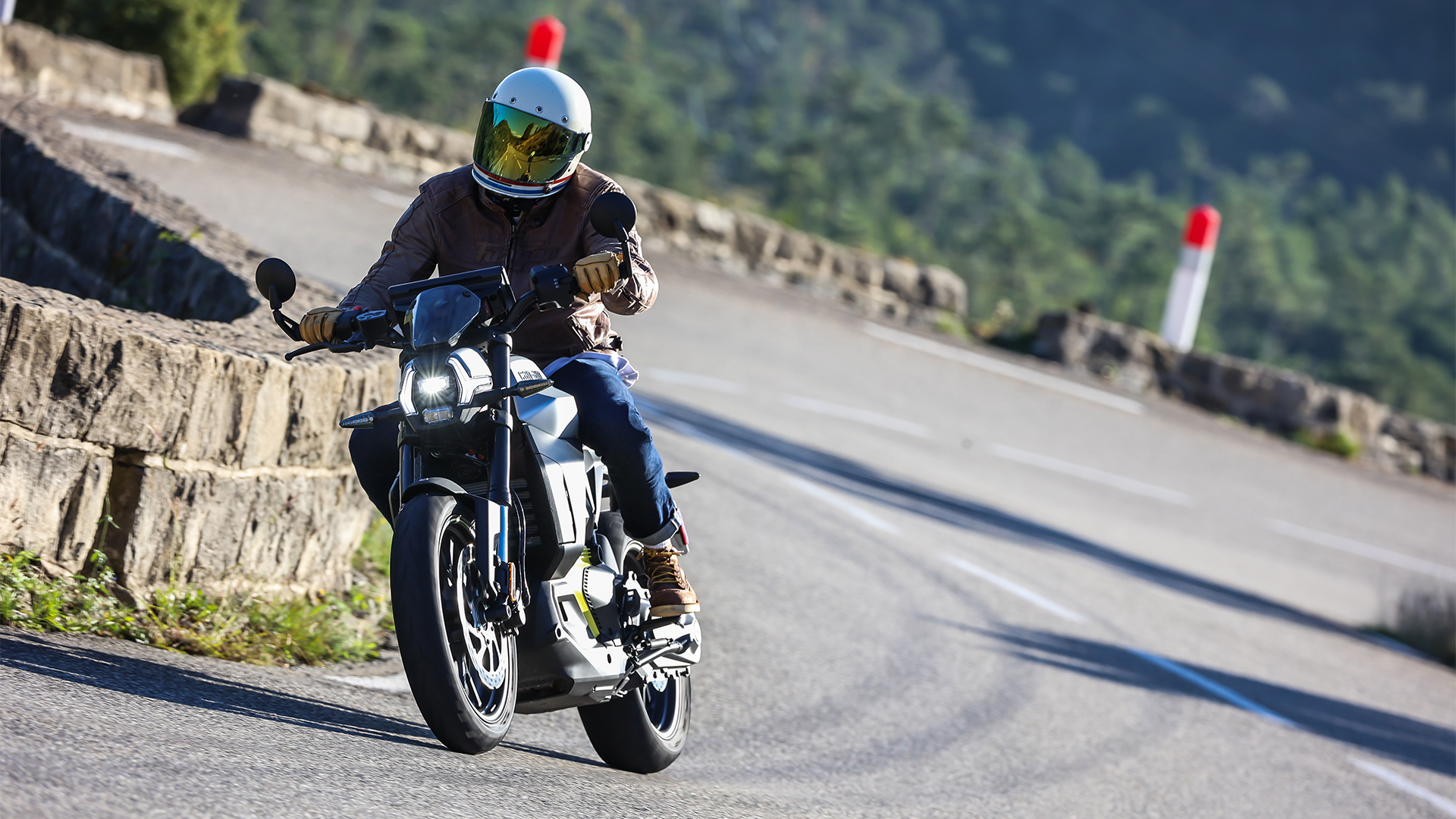
Although Can-Am representatives didn’t expressly admit this, I’d hazard a guess that the liquid cooling and chain case technology help the company keep costs down, thanks to it being used across both bikes, as well as its wider off-road portfolio.
It's a similar story with the battery packs, as these too have been developed in-house by its Rotax brand and are already in use in other products. Although, Can-Am refuses to reveal the source of its cells.
The upside is that this technology has been tried and tested on 200hp snowmobiles that have a penchant for being punished on the mountainside, so there are few questions hanging over the technology's reliability.
Screen time
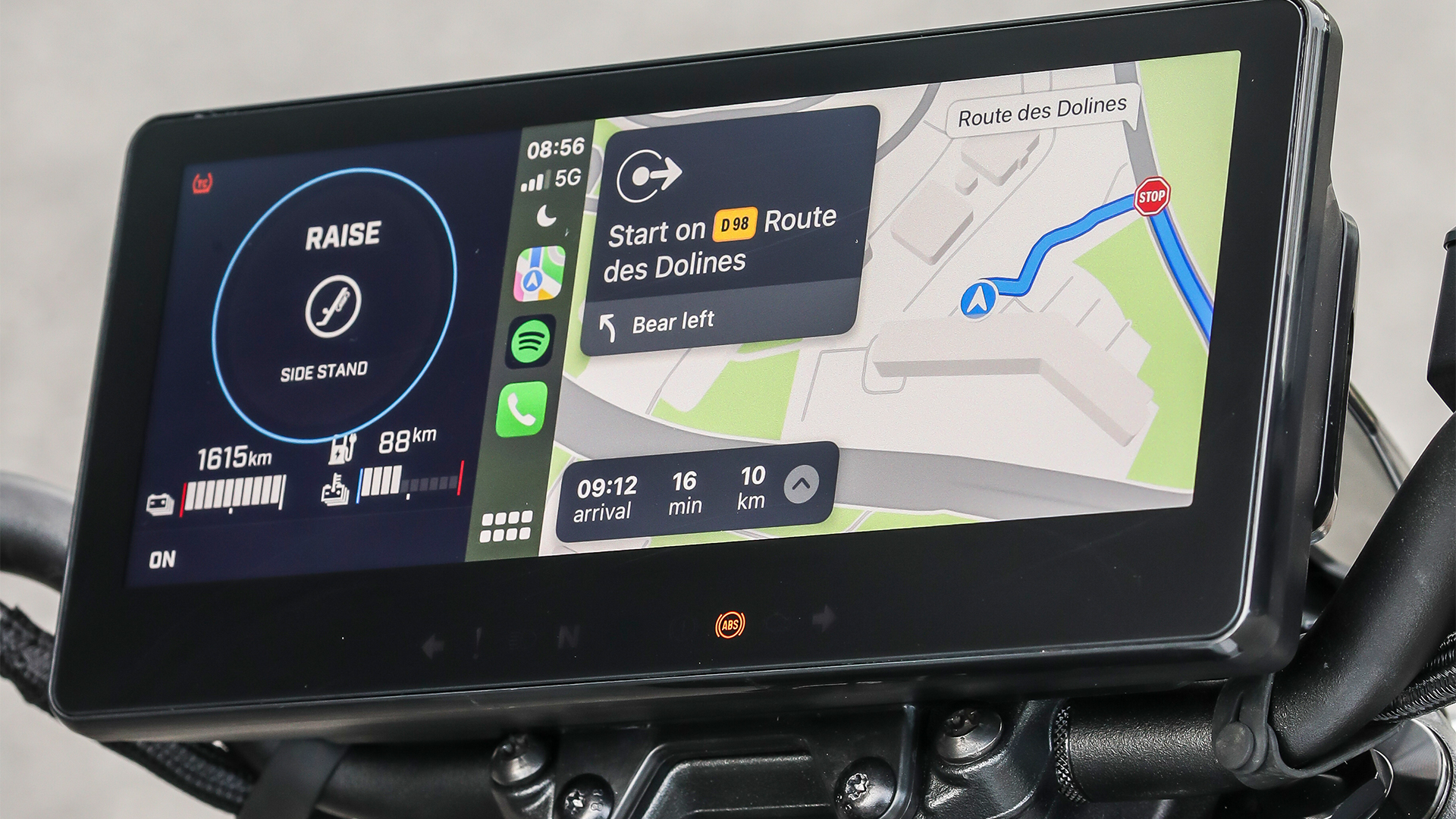
Far from being the most carefully integrated piece of design, there’s no denying the generous real estate offered by the 10.25-inch touchscreen. Again, destined to be used across various BRP products, it can be operated with gloved hands, in wet weather and will generally stand up to abuse.
It gives all of the required readouts on speed and remaining range, as well as providing a way to cycle through the various riding modes (Eco, Rain, Normal and Sport+) and access the Apple CarPlay interface.
The BMW CE04 electric scooter arguably does a better job of integrating a massive screen into the bike's cockpit, but once an iPhone is plugged in via the decidedly retro USB slot, Apple Car Play neatly takes up two thirds of the screen and proves a boon for navigating.
When paired (via Bluetooth) to a helmet-mounted headset and mic, it also allows for Siri voice commands to be activated, mapping via Google or Apple Maps and access to all of the usual CarPlay applications.

Riders can’t use the touchscreen when traveling, beyond crawling speeds for safety reasons, but Can-Am has provided a gargantuan control unit that’s mounted to the handlebars. Sorry guys, it’s just plain ugly, but it does the trick.
The only issue I had was with ergonomics. During the test ride, I kept prodding the button that cycled through instrument cluster layout, rather than the button that dealt with riding modes, traction control and other important rider systems.
This was because Can-Am hadn’t mounted the latter button in the section of the large cluster that felt most natural to the rider (in other words, the section that also houses the indicator and horn buttons). I mentioned this to the team and, thanks to these being pre-production bikes, they say it's an issue that will likely get sorted before production commences.
Similarly, the aforementioned storage access was clunky, with a button that liked to get stuck, while some of the plastics felt overly cheap for a bike of this price. Hopefully, these points will be addressed before production starts later this year.
Although some motorcycle manufacturers are now providing larger displays on their bikes, it’s still rare to see a massive digital slab like this offered as standard. It’s certainly not the prettiest, but it’s extremely handy for hands-free navigation, listening to audio or receiving message alerts.
Can-Am also hinted that it was working on its own navigation system that could reside natively on the infotainment system, negating the need to plug in a smartphone. But seeing as many of its customers venture off-road, it needs to make sure it performs across its entire portfolio before releasing it into the wild.
A ride apart

Electric motorcycle skeptics need to ride a Can-Am Pulse or Origin before forming an opinion on their inferiority to petrol-powered bikes. The instantaneous torque is addictive and the Pulse carves through mountain passes with agile, predictable glee. It’s a great handling machine.
Can-Am has also introduced arguably one of the best regenerative braking systems I have ever experienced on an electric motorcycle. It’s possible to select between various levels of regen (nothing new there) but riders can also roll the throttle forwards to initiate the most aggressive mode.
Not only is this a great way to cruise around town without touching the brakes, it also adds an impressive amount of range to the battery packs under the right conditions.
For example, I started a descent of a twisty mountain pass with 34km of range remaining on the digital display. By the time I arrived at the foot of the pass, the system reported I could travel 59km.
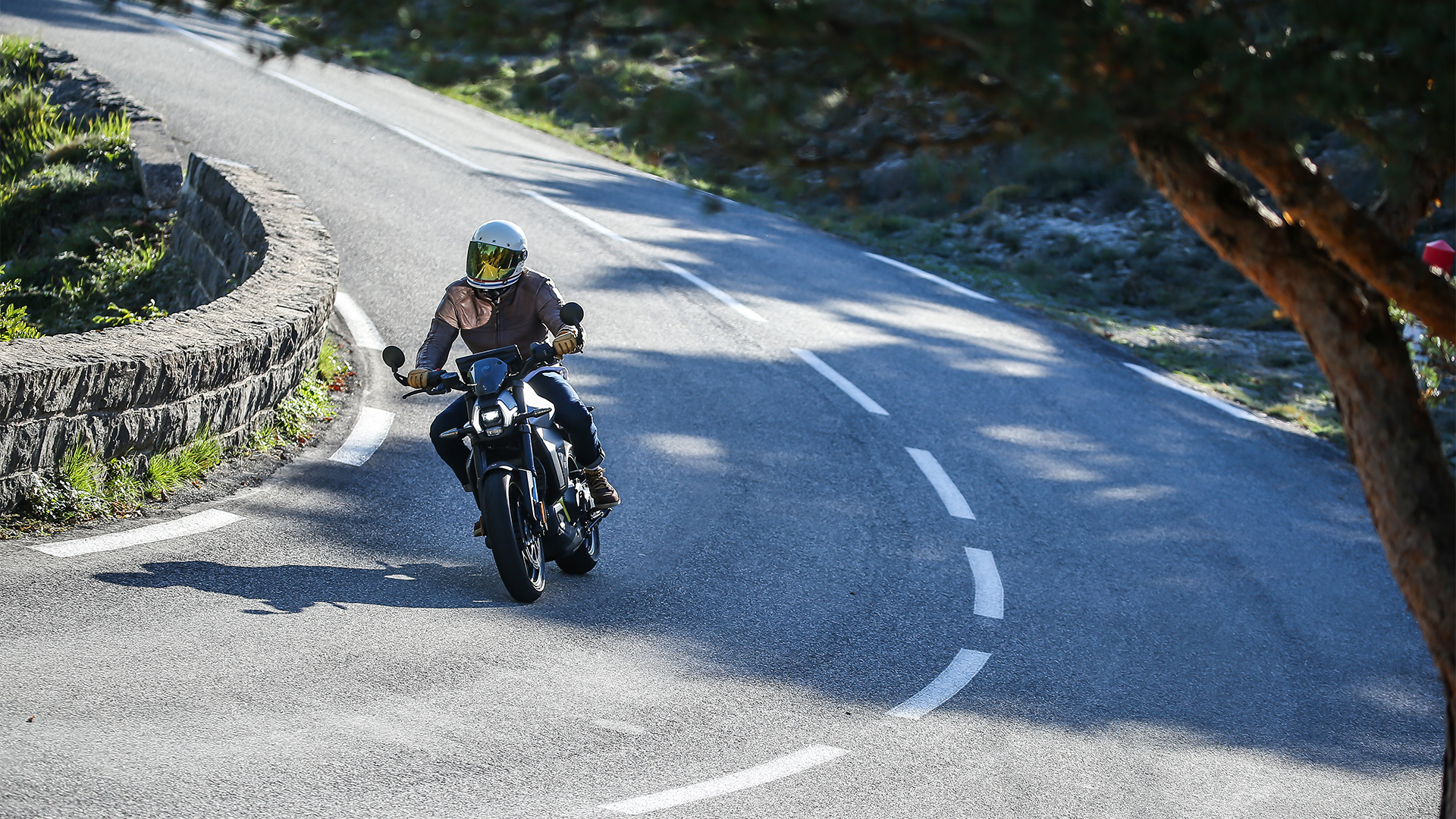
Granted, this is a calculation based on the most recent riding conditions, but the battery charge indicator stayed in the same position, despite covering a good 15 to 20km. Using regen braking and anticipating the turns, rather than relying on the sometimes slightly wooden-feeling brakes, equates to free energy. Show me a petrol-powered bike that can do that.
With an overall range of around 100 miles and a top speed of 80mph, the Can-Am Pulse is perfectly adept at exploring further than the city limits. Plus, the reliable range estimation and generous regen system largely rids riders of any sort of range anxiety.
That said, unlike select models from rivals Zero Motorcycles, which include a more advanced charging system, the Can-Am Pulse and Origin can only be topped-up at a max rate of 6.6kW, which sees a 20-80% charge take 50 minutes.
Tough competition
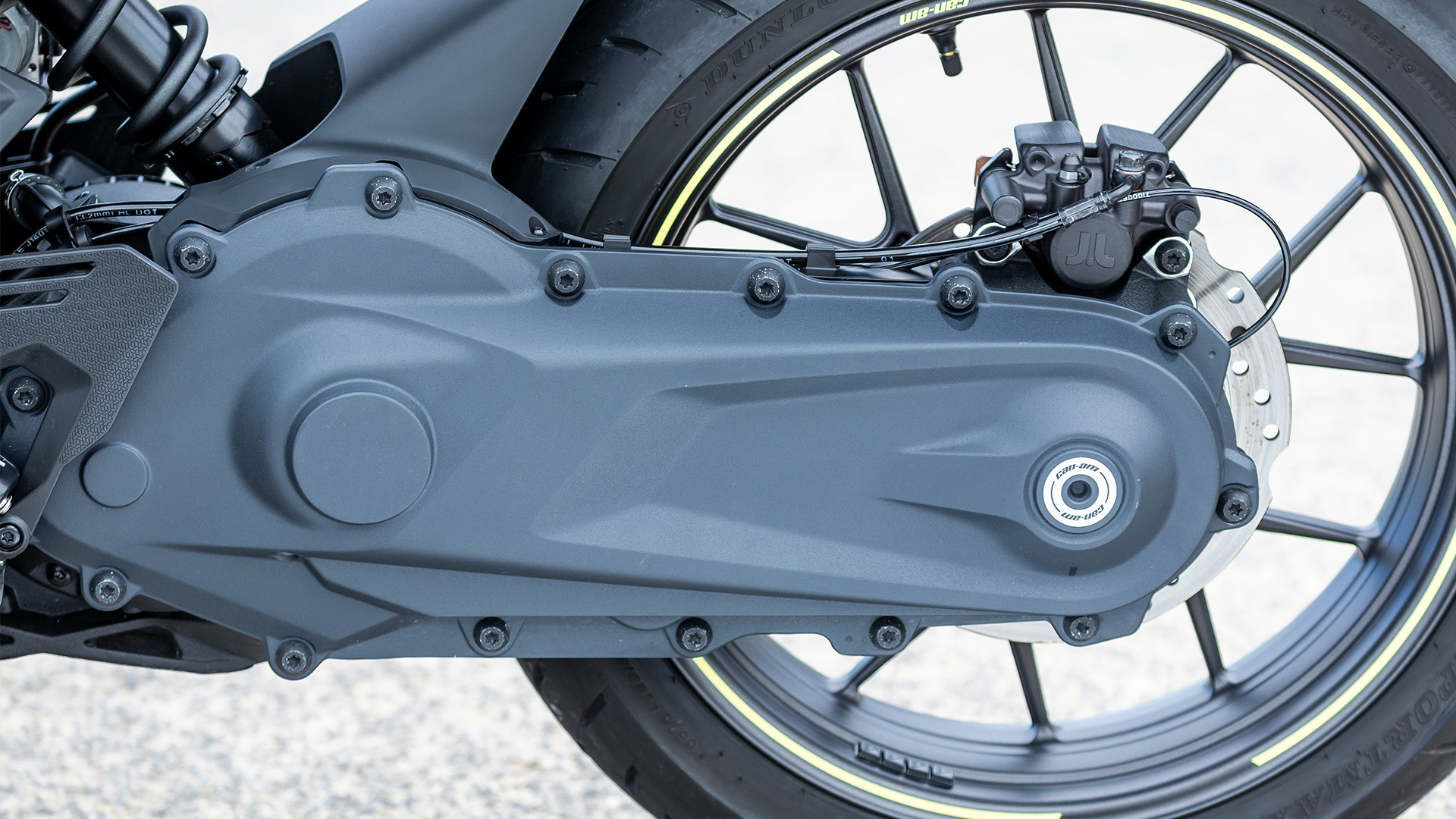
There’s no denying that the electric two-wheeler market is a perilous place to operate in these days. Only recently, Italian innovators Energica filed for bankruptcy. It’s the same story for US eBike and motorcycle-maker FUELL, as well as slightly whacky Swedish brand Cake.
Harley-Davidson’s sales figures of its LiveWire One and S2 Del Mar models make for painful reading (an operating loss of $33.8 million at the end of last year), while Kawasaki’s Ninja e-1 is so underpowered, expensive and offers such a ridiculously poor electric range, it’s difficult to work out exactly who will buy one.
Zero Motorcycles represent the fiercest rival for Can-Am’s recent offerings, with the Zero S model coming closest in terms of price. It has a larger battery pack, more peak power and a slightly higher top speed, but it is heavier, the range is largely similar and it’s around £1,000 / $1,000 more expensive.
Can-Am is clearly taking a punt here, hinting that it has two more electric models based on the same powertrain platform in the pipeline. But the company has boxed clever, using its economies of scale to share tried-and-tested parts across its wider range.

This will assist in producing favourable profit margins, while its network of 3,000 dealers in 130 countries around the world will be a huge advantage over many rivals in the simple act of getting the Pulse and Origin in the hands of buyers.
Like their passenger car counterparts, electric motorcycles are still very expensive and there are the same compromises when it comes to potential range and charging. But the Can-Am models ride well and offer a generous level of technology as standard.
There's also a great line of well-designed accessories that clip on without the need for tools, including panniers, top boxes and screens that all use the company's Linq fixing system. It's a simple, fuss-free way of personalizing a ride, as well as making it more practical.
Perhaps above all else, the lower-powered 11kW models are great for new riders or those less confident on two wheels. They look identical, perform admirably, yet require far less in the way of rider training.
It feels like this is where Can-Am could make an impact and the company’s first offering is good enough to do just that.
You might also like

Leon has been navigating a world where automotive and tech collide for almost 20 years, reporting on everything from in-car entertainment to robotised manufacturing plants. Currently, EVs are the focus of his attentions, but give it a few years and it will be electric vertical take-off and landing craft. Outside of work hours, he can be found tinkering with distinctly analogue motorcycles, because electric motors are no replacement for an old Honda inline four.